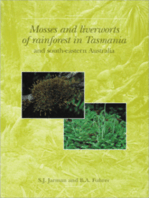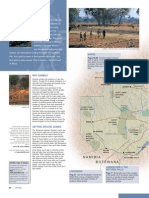Gleichenia Microphylla Notesheet
Gleichenia Microphylla Notesheet
Uploaded by
Yuliana PurnamasariCopyright:
Available Formats
Gleichenia Microphylla Notesheet
Gleichenia Microphylla Notesheet
Uploaded by
Yuliana PurnamasariOriginal Description:
Original Title
Copyright
Available Formats
Share this document
Did you find this document useful?
Is this content inappropriate?
Copyright:
Available Formats
Gleichenia Microphylla Notesheet
Gleichenia Microphylla Notesheet
Uploaded by
Yuliana PurnamasariCopyright:
Available Formats
Flora of Tasmania
Naomi Lawrence
Description
As its name implies, scrambling coralfern has an untidy scrambling habit. It has a
long creeping rhizome with forked branches, which is covered when young with
brown, fringed scales.
The long, brown lower frond stems (stipes), which arise at intervals along the
rhizome, are usually without scales, bristles or hairs when mature. The fronds are
erect or scrambling, open and much branched, usually with several tiers of branch
systems so the plants are often more than 1.5 m tall. Like other members of this very
distinctive genus, scrambling coralfern has forked fronds.
The primary upper frond stem (rachis) branches fork two or three times. The upper
frond stems are covered with numerous, conspicuous bundles of short, shiny, amber to
dark brown bristles, together with less numerous and scattered, fringed scales. The
young parts and dormant apices of the fronds are protected by shiny, brown, fringed
scales and star-shaped hairs.
The leafy part of the frond is twice divided. The primary divisions (pinnae) are
26 cm long and lobed. Each pinna is further divided into small, close-set pinnules,
which (along with the rachis) lack hairs or scales on the under surface. The pinnules
are stalkless, small (13 mm long), oblong-triangular and blunt, with the lower
surface flat or slightly concave.
The spore clusters (sori) contain 25 spore sacs (sporangia) grouped around a central
projection. Each spore sac (sporangium) is large, almost globular, shiny and bright
yellow to yellow-brown in colour, splitting vertically when the spore is mature.
Confusing species
Pouched coralfern (Gleichenia dicarpa) and alpine coralfern (Gleichenia alpina) are
very similar in appearance to scrambling coralfern. However, scrambling coralfern
has flat pinnules and bare pinnae and rachis, whereas alpine coralfern and pouched
coralfern have pouched pinnules.
Gleichenia microphylla
FAMILY: Gleicheniaceae
BOTANICAL NAME: Gleichenia microphylla
COMMON NAME: scrambling coralfern
CONSERVATION SIGNIFICANCE:
None recorded
Gleichenia microphylla
Flora of Tasmania
Distribution and Habitat
Distribution of Gleichenia microphylla in Tasmania 2004 data.
In Australia, scrambling coralfern is common and widespread, occurring in Victoria,
Tasmania, South Australia, New South Wales, Queensland and Western Australia.
It has similar habitat requirements to pouched coralfern and the two species have
virtually the same distribution and frequently grow together. Like pouched coralfern,
scrambling coralfern occurs in poorly-drained and permanently wet soils within
heathlands, riparian areas, dry eucalypt forest and woodland. It is often locally
abundant along watercourse margins and other swampy areas where there is adequate
light.
Ecology
Scrambling coralfern has similar light and habitat requirements to pouched coralfern,
both requiring constant moisture around their roots and sun on their fronds. Under
such conditions, scrambling coralfern forms thickets that can be over 3 m tall, by
scrambling up and being supported by nearby vegetation. Where moisture is adequate,
dwarfed plants can also be found on exposed banks among rocks.
Scrambling coralfern is very hardy and can tolerate salt-laden winds in coastal
situations.
Potential for Cultivation
Scrambling coralfern has good potential for cultivation and it can be readily raised
from ripe spores. Ripe spore is indicated by the colour of the spore clusters, which are
dark brown or black when mature. It is, however, particularly difficult to transplant
mature plants, although very small plants transplant easily. In either case, this species
will not tolerate drying out of the root system and is intolerant of lime and fertilisers.
If treated appropriately, scrambling coralfern adapts well to pot or tub culture and is
an attractive species in cultivation.
Gleichenia microphylla
Flora of Tasmania
Information Sources
Garrett, M. (1996) The Ferns of Tasmania. Their Ecology and Distribution.
Tasmanian Forest Research Council, Hobart.
Duncan, B.D. & Isaac, G. (1986) Ferns and Allied Plants of Victoria, Tasmania and
South Australia. Melbourne University Press, Carlton, Victoria.
J ones, D.L. & Clemesha, S.C. (1976) Australian Ferns and Fern Allies with Notes on
Their Cultivation. Reed, Sydney, London.
Understorey Network. Tasmanian Native Species Database. www.understorey-
network.org.au
You might also like
- Name of Plants in The Damara TraditionsDocument5 pagesName of Plants in The Damara TraditionsHafeni tulongeni HamukotoNo ratings yet
- Bruguiera Gymnorrhiza (Large-Leafed Mangrove) : Species Profiles For Pacific Island AgroforestryDocument15 pagesBruguiera Gymnorrhiza (Large-Leafed Mangrove) : Species Profiles For Pacific Island Agroforestryjumiati_jumyNo ratings yet
- Kinds of LichensDocument4 pagesKinds of LichensRovic MelladoNo ratings yet
- RhodophytaDocument22 pagesRhodophytaCHESSA MAY OLITANNo ratings yet
- Alocasia Melo - (Curtis's Botanical Magazine 14 (2) 82GÇô86, Pl. 315) - Hay, Boyce & Wong 1997Document6 pagesAlocasia Melo - (Curtis's Botanical Magazine 14 (2) 82GÇô86, Pl. 315) - Hay, Boyce & Wong 1997بدريانشاNo ratings yet
- Classification of MossesDocument32 pagesClassification of MossesMuthiaranifs86% (7)
- Hagnaya VineDocument6 pagesHagnaya VineAnonette RamosNo ratings yet
- Carter 1992Document5 pagesCarter 1992Jhon W. MuñuicoNo ratings yet
- 0000 AaDocument1 page0000 Aadiktatorimhotep8800No ratings yet
- GREEK_244_GUIDEDocument3 pagesGREEK_244_GUIDEayylmao1234wthNo ratings yet
- Senna SiameaDocument5 pagesSenna SiameaSulistyawati WrimunNo ratings yet
- Tropical AlmondDocument9 pagesTropical AlmondHanarisha Putri AzkiaNo ratings yet
- Acer PlatanoidesDocument2 pagesAcer PlatanoidesNVAzirNo ratings yet
- Mosses and Liverworts of Rainforest in Tasmania and South-eastern AustraliaFrom EverandMosses and Liverworts of Rainforest in Tasmania and South-eastern AustraliaNo ratings yet
- Flora Zambesiaca Volume 13 Part 4: Xyridaceae, Eriocaulaceae, Typhaceae, Restionaceae, Flagellariaceae, Juncaceae, Musaceae, Strelitziaceae, Costaceae, Zingiberaceae, Cannaceae, MarantaceaeFrom EverandFlora Zambesiaca Volume 13 Part 4: Xyridaceae, Eriocaulaceae, Typhaceae, Restionaceae, Flagellariaceae, Juncaceae, Musaceae, Strelitziaceae, Costaceae, Zingiberaceae, Cannaceae, MarantaceaeNo ratings yet
- Panicum Capillare Adalah Spesies Tumbuhan Yang Tergolong Ke Dalam Famili Poaceae. SpesiesDocument4 pagesPanicum Capillare Adalah Spesies Tumbuhan Yang Tergolong Ke Dalam Famili Poaceae. Spesiesroy gunawanNo ratings yet
- Variety of Plants in The PhilippinesDocument17 pagesVariety of Plants in The PhilippinesMekaela DiataNo ratings yet
- BrassicaceaeDocument68 pagesBrassicaceaesujithagopinathan785No ratings yet
- Bamboo Research PaperDocument24 pagesBamboo Research PaperShanaia BualNo ratings yet
- 3 Endangered Plant SpeciesDocument7 pages3 Endangered Plant SpeciesBharat SinghNo ratings yet
- Marsilea Crenata: PteridophyteDocument9 pagesMarsilea Crenata: PteridophyteNur Rezki OctaviaNo ratings yet
- Cajaninae of Australia (Leguminosae: Papilionoideae) : L. J. G. Van Der MaesenDocument9 pagesCajaninae of Australia (Leguminosae: Papilionoideae) : L. J. G. Van Der MaesenSheilla Moreno PérezNo ratings yet
- Monografia 3Document37 pagesMonografia 3forsosialcyNo ratings yet
- The Green Glen ImagenDocument22 pagesThe Green Glen ImagenMartin CriscioneNo ratings yet
- Wader Greater Yellowlegs Spotted Redshank Shanks Paraphyletic WilletDocument2 pagesWader Greater Yellowlegs Spotted Redshank Shanks Paraphyletic WilletbobbysskNo ratings yet
- Osmunda Regalis: Common Name-Royal FernDocument2 pagesOsmunda Regalis: Common Name-Royal Fernapi-24654338No ratings yet
- The Genus Morinda (Rubiaceae) in ThailandDocument9 pagesThe Genus Morinda (Rubiaceae) in ThailandTasnuba JahanNo ratings yet
- Native Tree Info NSWDocument14 pagesNative Tree Info NSWSherrin DunlevieNo ratings yet
- Sugar Cane Morphology - ProjectDocument6 pagesSugar Cane Morphology - Projectsulha mNo ratings yet
- Acacia Burkei - ADocument4 pagesAcacia Burkei - ARuelNo ratings yet
- 23DCDocument18 pages23DCCasandra PalaciosNo ratings yet
- FloraDocument10 pagesFloramelchie100% (1)
- Karroo Thorn (Acacia Karroo) : The ProblemDocument6 pagesKarroo Thorn (Acacia Karroo) : The Problemglhfu2No ratings yet
- Final Demo SlidesDocument25 pagesFinal Demo SlidesJullemar GuladaNo ratings yet
- Gnetum Gnemon (Gnetum) : Species Profiles For Pacific Island AgroforestryDocument9 pagesGnetum Gnemon (Gnetum) : Species Profiles For Pacific Island AgroforestryKhusnaainunNo ratings yet
- Convolvulaceae NotasDocument43 pagesConvolvulaceae Notascesar3126No ratings yet
- Group 4Document12 pagesGroup 4rtibulan03No ratings yet
- Erythrina Crista-Galli: Infestation (Photo: Sheldon Navie)Document3 pagesErythrina Crista-Galli: Infestation (Photo: Sheldon Navie)YudaHendriawanNo ratings yet
- Mangrove Ag132e06Document58 pagesMangrove Ag132e06hanzo1260No ratings yet
- Eduart Zimer - Sarcocornia Quinqueflora (2008)Document12 pagesEduart Zimer - Sarcocornia Quinqueflora (2008)eduartzimerNo ratings yet
- evs ppt-1 new (1)Document31 pagesevs ppt-1 new (1)kcv1503fNo ratings yet
- RG 07-08 RWDocument3 pagesRG 07-08 RWJia ManceraNo ratings yet
- A.camansi BreadnutDocument11 pagesA.camansi BreadnutAlexandru NechitaNo ratings yet
- 23 - 2022 - Devecchi Et Al. - Flora DuckeDocument12 pages23 - 2022 - Devecchi Et Al. - Flora DuckeMarcelo DevecchiNo ratings yet
- Ferns: Sami Ali 2.BADocument11 pagesFerns: Sami Ali 2.BASami Ali 123No ratings yet
- Cabbage Tree Basin AutosavedDocument21 pagesCabbage Tree Basin AutosavedNONOONO YesNo ratings yet
- Shorea_javanicaDocument5 pagesShorea_javanicaNeil Eric PecacheNo ratings yet
- Types and Characteristics: Leonard Neil C. Jubane Swiza Aimee B. CastallaDocument5 pagesTypes and Characteristics: Leonard Neil C. Jubane Swiza Aimee B. CastallaJocelyn CorpuzNo ratings yet
- Brassicaceae NotesDocument2 pagesBrassicaceae Notessamuel maina100% (1)
- There Are Ferns in Most New ZealandersDocument45 pagesThere Are Ferns in Most New ZealandersMudjaijah draNo ratings yet
- R I S E: Esearch Nformation Eries On CosystemsDocument52 pagesR I S E: Esearch Nformation Eries On CosystemsBernadette SanchezNo ratings yet
- Phylum Bryophyta: Group MembersDocument29 pagesPhylum Bryophyta: Group MembersAkil DhoniNo ratings yet
- Mycena - Making A Start On MycenaDocument11 pagesMycena - Making A Start On MycenassjkrillenNo ratings yet
- Green 2002Document51 pagesGreen 2002ΑΝΑΣΤΑΣΙΑ ΝΕΡΑΝΤΖΗNo ratings yet
- Taxonomic ClassificationDocument2 pagesTaxonomic ClassificationDarrel TangonanNo ratings yet
- Art IntegrationDocument6 pagesArt IntegrationVaishnavi satishNo ratings yet
- Synopsis of The Genus Salix (Salicaceae) in Southern AfricaDocument7 pagesSynopsis of The Genus Salix (Salicaceae) in Southern AfricadrvenkataNo ratings yet
- Transpiration: Function of Water in LeavesDocument5 pagesTranspiration: Function of Water in LeavesYuliana PurnamasariNo ratings yet
- Fei World Dressage Challenge - Medium Test: CollectedDocument3 pagesFei World Dressage Challenge - Medium Test: CollectedYuliana PurnamasariNo ratings yet
- Marine VisionDocument16 pagesMarine VisionYuliana PurnamasariNo ratings yet
- BIOTECH Project, University of Arizona DNA Extraction From KiwifruitDocument2 pagesBIOTECH Project, University of Arizona DNA Extraction From KiwifruitYuliana PurnamasariNo ratings yet
- 71 142 1 PBDocument5 pages71 142 1 PBYuliana PurnamasariNo ratings yet
- How To Make A Pencil BoxDocument2 pagesHow To Make A Pencil BoxYuliana PurnamasariNo ratings yet
- 3.2. Pembelahan Meiosis Dan FertilisasiDocument32 pages3.2. Pembelahan Meiosis Dan FertilisasiYuliana PurnamasariNo ratings yet
- Describing A Process - Exercise - 3Document1 pageDescribing A Process - Exercise - 3Yuliana PurnamasariNo ratings yet
- Asia's Suffering Bears Exploited For BileDocument2 pagesAsia's Suffering Bears Exploited For BileYuliana PurnamasariNo ratings yet
- Art Integrated Learning Project-Khushi Mishra (X A)Document12 pagesArt Integrated Learning Project-Khushi Mishra (X A)Khushi MishraNo ratings yet
- Newsletter Winter Jan 2015Document4 pagesNewsletter Winter Jan 2015api-260306731No ratings yet
- Behavioural and Ecological Consequences of Urban Life in BirdsDocument364 pagesBehavioural and Ecological Consequences of Urban Life in BirdsYan TrovatoNo ratings yet
- Benefits of Wildlife ConservationDocument29 pagesBenefits of Wildlife ConservationJayachandran KSNo ratings yet
- Salvaging Rifts With BRP and The Morrow Project..Document4 pagesSalvaging Rifts With BRP and The Morrow Project..sellnegNo ratings yet
- AOC 2015 - Final Program FullDocument107 pagesAOC 2015 - Final Program FullLiliana AyalaNo ratings yet
- Land ReclaimDocument14 pagesLand ReclaimMartin Sabah100% (1)
- Mega Diversity CentreDocument12 pagesMega Diversity CentreVaibhav RohraNo ratings yet
- Constructed Wetlands Green-FiltersDocument33 pagesConstructed Wetlands Green-FiltersThabiso Jacob MokwenaNo ratings yet
- Karakoram Knowledge Highways (KKH) Issue 3Document82 pagesKarakoram Knowledge Highways (KKH) Issue 3Zulfiqar Ali Khan100% (1)
- Competition and Succession in Pastures - Some Concepts and QuestionsDocument14 pagesCompetition and Succession in Pastures - Some Concepts and QuestionskostyxNo ratings yet
- A Structured Elicitation Method To Identify Key Direct Risk Factor - 2015 - HeliDocument21 pagesA Structured Elicitation Method To Identify Key Direct Risk Factor - 2015 - Helipo hongNo ratings yet
- Environment Thesis TitleDocument8 pagesEnvironment Thesis Titleevkrjniig100% (2)
- Unidad 2-Parte 8Document5 pagesUnidad 2-Parte 8Elmer CardonaNo ratings yet
- CCCS BC Parks GuideDocument104 pagesCCCS BC Parks GuideWastewise100% (1)
- Dialium IndumDocument3 pagesDialium IndumNur Farhanah ZulkifliNo ratings yet
- Zambia Map & IntroductionDocument2 pagesZambia Map & Introductioninfo@zcfcanada.org100% (1)
- Biodiversity NotesDocument8 pagesBiodiversity NotesGeeta TikkeNo ratings yet
- How Is The Philippines Affected by Climate ChangeDocument2 pagesHow Is The Philippines Affected by Climate ChangeQueenie SantosNo ratings yet
- Article Shell Thiocrete Land Water NL April 2013Document3 pagesArticle Shell Thiocrete Land Water NL April 2013Verma NverNo ratings yet
- Ytse JousmaDocument24 pagesYtse JousmaCarlos Andrés Hernández ArriagadaNo ratings yet
- Chapter 10 Wild Life in EthiopiaDocument8 pagesChapter 10 Wild Life in Ethiopiaberihun admassuNo ratings yet
- Forestry Forest ManagementDocument2 pagesForestry Forest ManagementbharanikantNo ratings yet
- Delhi Evolution Along YamunaDocument59 pagesDelhi Evolution Along YamunaAjay JainNo ratings yet
- ORF OccasionalPaper 317 BlueGreenInfrastructureDocument38 pagesORF OccasionalPaper 317 BlueGreenInfrastructureMd IbrahimNo ratings yet
- Fahri Dan Sataral M, Agustus 2015 PDFDocument9 pagesFahri Dan Sataral M, Agustus 2015 PDFMihwan SataralNo ratings yet
- Highlights of Gadgil ReportDocument20 pagesHighlights of Gadgil ReportGomathy AiyerNo ratings yet
- Okavango Delta Management Plan: Hydrology and Water ResourcesDocument78 pagesOkavango Delta Management Plan: Hydrology and Water ResourcesAse JohannessenNo ratings yet
- The Van Gogh GeckoDocument3 pagesThe Van Gogh Geckobahardagkan02No ratings yet
- NCCF - COP14 UNCCD FlyerDocument2 pagesNCCF - COP14 UNCCD FlyerAnuraag RajNo ratings yet


































































































